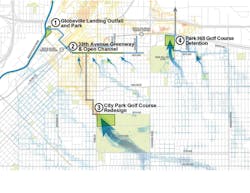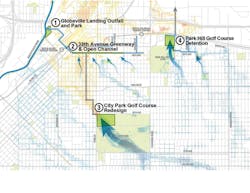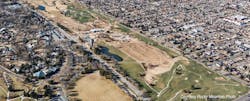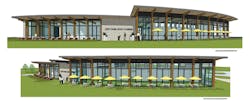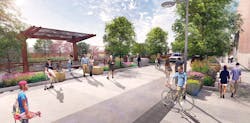Flood Protection in Denver
A four-project approach
By Sarah Anderson
In 2013, much of Colorado’s Front Range — stretching across Denver and its surrounding areas — experienced significant flood damage to homes, businesses, and public infrastructure. The multi-day storm caused an estimated $4 billion in damage across twenty-four Colorado counties, displaced 18,000 people, destroyed more than 1,800 homes and 200 businesses, and nearly wiped out 30 state highway bridges and miles of rail lines. Although northern parts of Colorado were hit the hardest, several neighborhoods in Denver experienced severe flooding, and it served as a strong reminder that these events can occur at any time with devastating effect.
Perhaps the largest at-risk area in Denver is the Montclair Basin, which not only is the largest watershed in the city but also lacks a meaningful outfall to the river. Stormwater modeling and previous storms showed that during moderate to large storm events, the existing pipe systems reach capacity and the excess runoff is carried on the surface at depths of three feet or more on many streets over multiple city blocks.
The Platte to Park Hill: Stormwater Systems project is a roughly $298 million coordinated approach consisting of four independent projects that, once complete, will provide critical flood protection, increase neighborhood connectivity and public spaces, and improve water quality and existing infrastructure for current and future community members in north Denver. Source: Design Workshop Inc.
In 2015, the City and County of Denver (city) committed to stormwater investments that would address flood protection in several north Denver neighborhoods. With new critical large-scale infrastructure investments planned for this urbanized area, the city recognized an opportunity to create a truly integrated stormwater solution for current and future community members that met the city’s goals of providing critical flood protection, improving water quality, increasing neighborhood connectivity, enhancing public spaces, and upgrading existing infrastructure with green elements.
The city would meet these goals through planning, design and construction of four projects, and hired Matrix Design Group to manage collaboration among project teams and the numerous city and county agencies. To simplify the overall process and project timelines, each project would have separate procurement processes and schedules but would be referenced under one collective program known as the Platte to Park Hill: Stormwater Systems Program.
With support from Saunders Construction, iCon Golf Studio and Hale Irwin Golf Design provided design and architecture services for the new golf course. Source: iCon Golf Studio; Design Workshop Inc.
The four areas of Platte to Park Hill include:
• City Park Golf Course
• 39th Avenue Greenway and Open Channel
• Globeville Landing Outfall and Park
• Park Hill
The projects will create two new regional stormwater facilities with enhanced water quality features at City Park Golf Course and Park Hill Golf Course, a linear greenway along 39th Avenue and an enlarged storm sewer outfall in Globeville Landing Park.
December 2018 aerial view of the City Park Golf Course. Source: Rocky Mountain Photography.
Using Integrated Stormwater Facilities
One of the most visible projects, due to its high-traffic and prominent location in Denver and functional transformation, is the City Park Golf Course Redesign.
Golf courses have a proven track record of providing neighboring communities with effective flood control. Integrating detention basins into a course creates a natural holding area for stormwater and creates golf water hazards throughout the course. The purpose of the detention basin is to temporarily hold and slowly release water during flooding events, protecting the nearby communities.
Golf courses also provide a great opportunity for regional water quality. Through the “daylighting” of existing storm drain pipes under the golf course, the city was able to create natural bioswales that treat urban runoff. Base flows from the Upper Montclair Basin now enter the golf course and “process” through a treatment train of trash removal, settling, natural infiltration and bioprocesses.
The 39th Avenue Greenway and Channel project will add nearly 12 acres of new recreational open space and increase connectivity in the Cole and Clayton neighborhoods. Source: Livable Cities Studio Inc.
During the early stages of the design process, working groups made up of local community members were created to ensure that the updated layout of the course would align with the needs of the community and frequent course players. The city incorporated community-driven aspects into the project, including a full-size, 300-yard driving range, new sidewalks, a park-like space throughout the course, a healthy reforestation plan in line with the city’s forestry guidelines, and the incorporation of sustainable design and construction throughout the project site. Upon completion, the course will boast an 18-hole, par-70 course and a new LEED Gold-certified clubhouse in addition to the critical flood protection aspects, such as natural channels and integrated detention areas.
Nearly two miles away at Park Hill Golf Course, the creation of a new stormwater management system consisting of stormwater detention basin and pipes in the Park Hill neighborhood will more effectively hold and slow stormwater that flows through the area in the event of a major storm or flooding. The new detention facility in Park Hill will provide similar water quality benefits to those being created at City Park Golf Course.
Johnson Nathan Strohe is serving as the architect for the clubhouse, which is expected to open in late 2019. The new clubhouse will be comprised of materials intended to mimic nature and is designed to achieve LEED Gold certification. Source: Johnson Nathan Strohe.
An Urban Greenway in the Montclair Basin
During a high flooding event, an open channel is better able to collect peak flows and convey to the river. The 39th Avenue Greenway is a stormwater channel project located in the Lower Montclair Basin, designed to intercept storm flows and direct them to newly constructed tunnels under the railroads and out to the South Platte River. The Greenway project is a unique opportunity to replace aging infrastructure in the area with nearly 12 acres of new recreational open space and increased connectivity.
Similar to the bioswales in City Park Golf Course, the 39th Avenue Greenway will collect flows from the basin through forebays and convey the runoff through natural swales. The new open channel and more than 10,000 linear feet of stormwater pipe will safely move water to the outfall at Globeville Landing Park.
The city collaborated with nearby neighborhoods to develop a list of desired community elements. Design working groups met on an ongoing basis to create design guidelines and vision boards that would enhance the project’s technical specifications, community building, and mobility and connectivity. This process enabled the city to uncover aspects most important to the community, which included gathering spaces with amenities and unique aesthetics, recreational spaces, increased safety, the incorporation of native landscapes and materials, and increased connectivity for pedestrians, drivers and bikers, all while creating a more natural drainage system.
The 39th Avenue Greenway will feature new pathways and bridges for pedestrians and drivers, 5,000 square feet of community gardens, over one mile of multi-use trails, and an outdoor amphitheater. Source: Livable Cities Studio Inc.
Once complete, the new open space will include enhanced community amenities such as new pathways and bridges for pedestrians and drivers, 5,000 square feet of community gardens, over one mile of multi-use trails, and an outdoor amphitheater, while also providing much-needed protection from flood water, reducing the risk for nearby homes and businesses.
At the end of the open channel, the redesign of Globeville Landing Park involves the addition of a new stormwater open channel that will direct water from the 39th Avenue Greenway and Open Channel into the South Platte River, naturally cleaning stormwater as it runs through.
Project planning for the Globeville Landing Outfall and Park began in 2015 via a robust public outreach program. The city looked to understand how residents were currently using the park and uncover their desires. Multiple public meetings, stakeholder interviews, focus groups and youth engagement events helped the city gain an understanding of how the park could best serve the community. Several key themes expressed included an active play area, multiple bicycle and pedestrian connections, outdoor amenities and improved safety.
To date, in the course of Platte to Park Hill, the city has attended nearly 250 community meetings, engaging with more than 1,700 individuals.
The 39th Avenue Greenway project will feature Denver’s first shared street. Source: DHM Design; Livable Cities Studio Inc.
One of the First Applications of the Green Infrastructure Implementation Strategy
Platte to Park Hill was included in the city’s Green Infrastructure Implementation Strategy, an initiative that aimed to improve water quality and reduce pollutants by identifying green infrastructure opportunities in Denver. A water quality scorecard was used to prioritize projects based upon a thorough assessment that analyzes everything from existing wet weather stormwater pollutant loads to project construction scenarios. The scorecard identified six high-priority basins (including the Montclair Basin) and five medium-high level priority basins.
Through this process, instead of unsystematically implementing projects in areas where water quality improvement wasn’t as critical, Denver could concentrate its efforts on the areas with the greatest need. This meant, too, that the city could optimize the value of the green infrastructure projects by prioritizing basins with issues beyond water quality, such as equity problems, income disparities and a lack of green space/low park density. Green infrastructure intends to alleviate, if not resolve, all of these issues by reducing flood risks, improving water and air quality, enhancing livability, increasing public health outcomes, and providing better connectivity within communities.
Water from the 39th Avenue Greenway open channel will be safely moved to the outfall at Globeville Landing Park, protecting nearby homes from flooding and improving the water quality. Upon completion, Globeville Landing Park will be a more desirable park, with increased connectivity and community amenities for nearby neighbors. Source: Design by Architerra Group; Rendering by Livable Cities Studio Inc.
While most of the Green Infrastructure Implementation Strategy projects are in the planning phases, the Platte to Park Hill: Stormwater Systems Program is now delivering on this promise. Like the overall strategy, Platte to Park Hill projects are utilizing new green infrastructure to improve water quality and protect against floods while adding a number of other benefits to Denver residents, like enhanced connectivity, safety and aesthetics of recreation spaces. In addition, these projects will help improve the health of the South Platte River and its tributaries, which is a major goal of the Green Infrastructure Implementation Strategy.
Construction on the four projects is currently underway with expected completion over the next two years. WW
About the Author: Sarah Anderson manages the Green Infrastructure Program for the City and County of Denver Public Works. She was hired in 2013 into a position new to Denver and has been responsible for creating and implementing a strategic and innovative stormwater program with a focus on green infrastructure implementation. She has been successful at creating a recognizable citywide program in just six years. With the creation of program metrics, Anderson worked to successfully secure $22 million dollars of new funding for the water quality/green infrastructure program over the next six years. She won the Public Works Employee of the Year Award in 2014 and the 5281 Mayors Sustainability Award in 2016. Prior to joining the City and County of Denver, Sarah was a consultant with Audubon Environmental, a consulting firm specializing in low-impact development and green infrastructure on large-scale private development projects.
